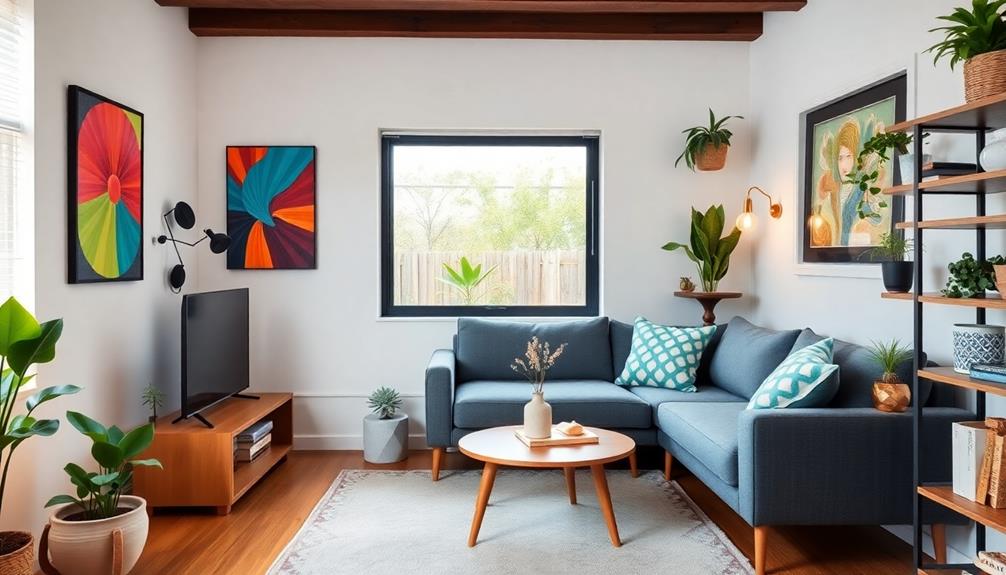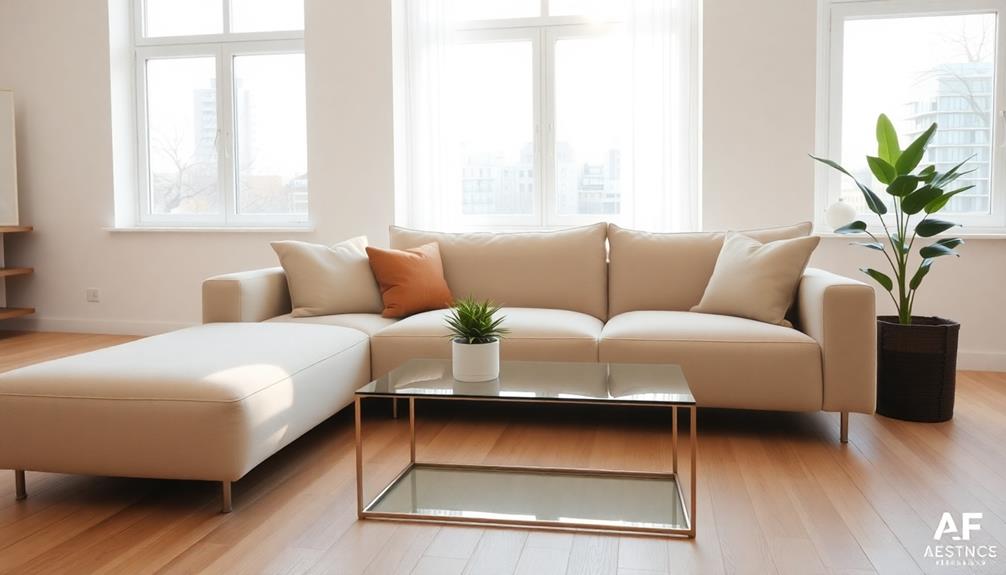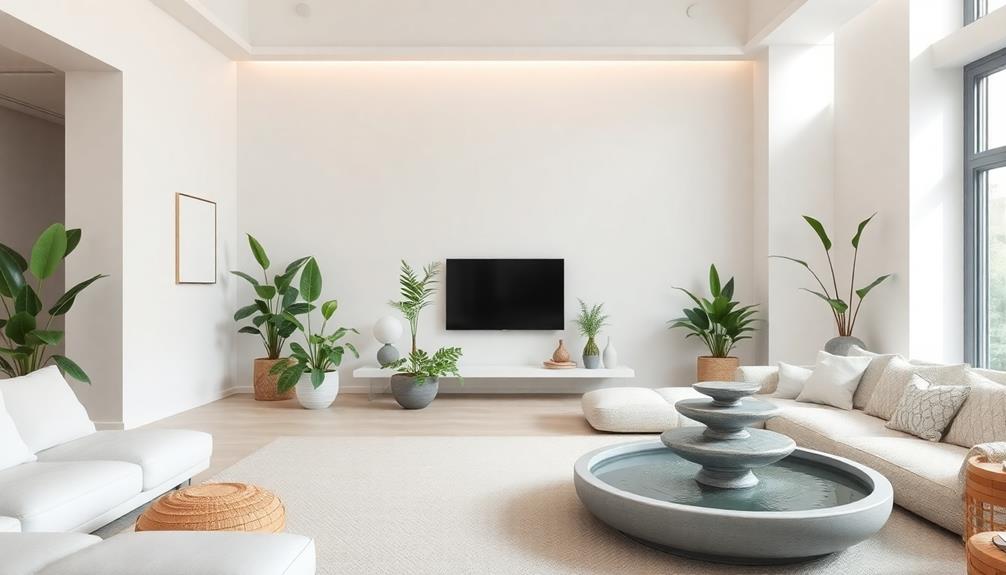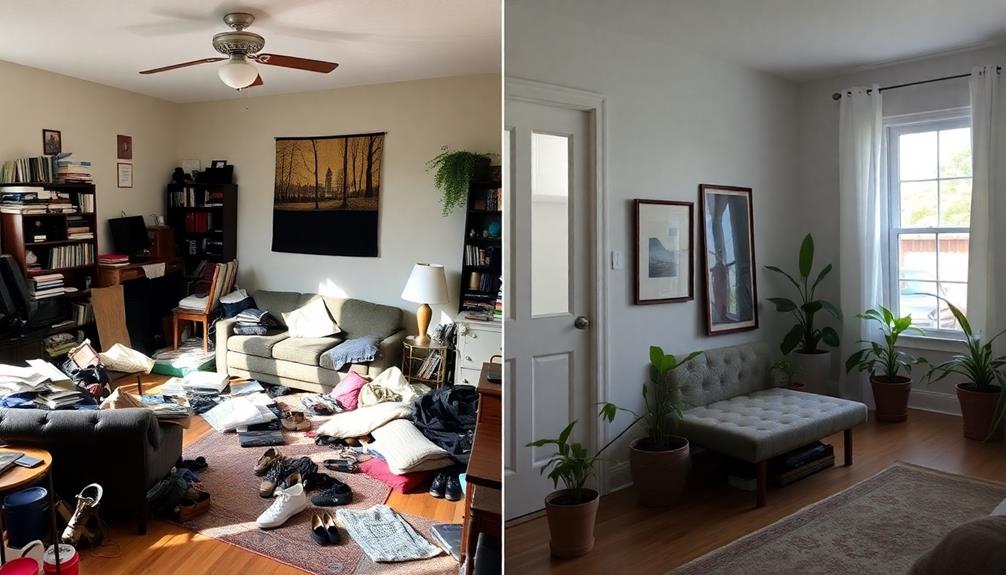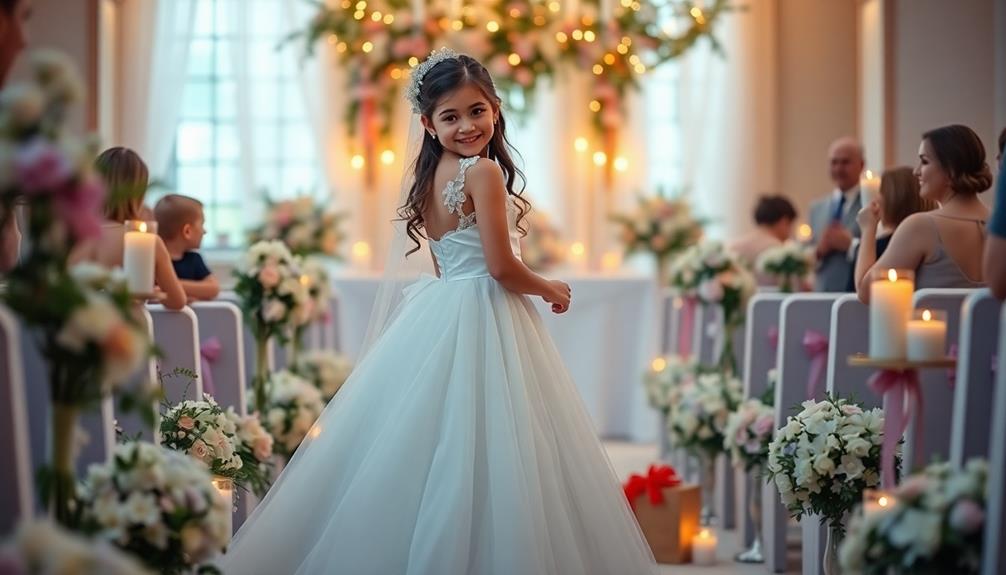You can easily turn tiny spaces into stylish retreats with smart design choices. Start by using multipurpose furniture like sofa beds and storage ottomans to maximize functionality. Opt for light colors and minimalism to create an airy feel. Incorporate vertical storage solutions, such as wall-mounted shelves, to free up floor space. Consider reflective elements to enhance brightness and depth. Unconventional layouts can improve flow, while custom pieces cater to your unique needs. With these tips, your small room can boast big style. Keep exploring for more innovative ideas to elevate your interior decor!
Key Takeaways
- Utilize multipurpose furniture like sofa beds and storage ottomans to maximize functionality in small spaces.
- Implement vertical storage solutions such as wall-mounted shelves to free up floor space and enhance organization.
- Choose light-colored and minimalistic furniture to create a sense of openness and balance within the room.
- Incorporate layered lighting to establish a warm and inviting atmosphere while meeting various functional needs.
- Customize furniture for unique layouts to optimize efficiency and reflect personal style in irregularly shaped rooms.
Maximizing Small Space Functionality
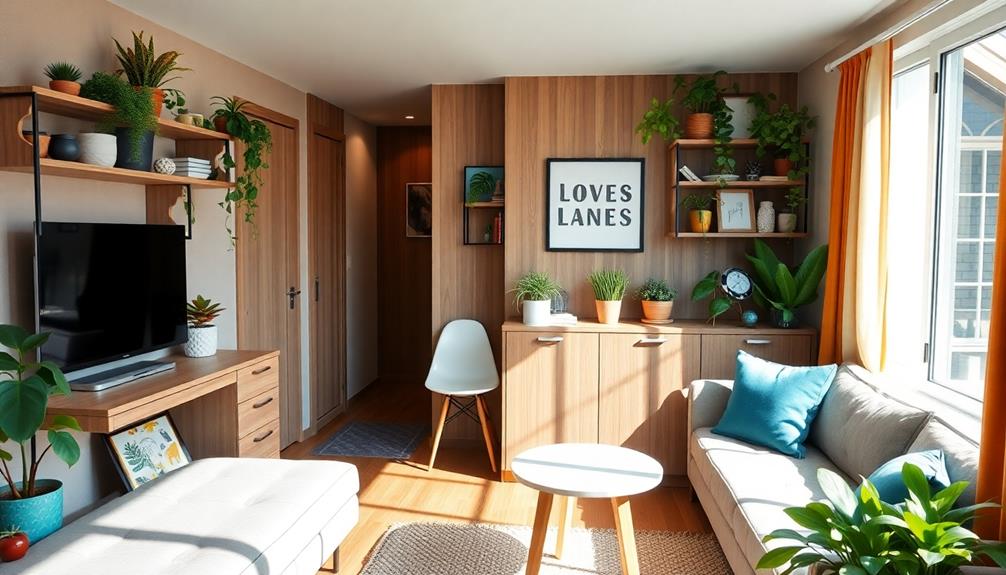
Maximizing functionality in tiny spaces can transform your living area into a well-organized haven. To make the most of your limited square footage, consider implementing multipurpose furniture. A sofa bed or a storage ottoman serves dual roles, offering both seating and extra storage without taking up unnecessary room.
Additionally, incorporating natural materials like wood and bamboo in your decor can add warmth and a touch of the outdoors, creating a calming atmosphere reminiscent of Balinese design characteristics.
You can also utilize vertical storage solutions like wall-mounted shelves or high cabinets. This approach frees up floor space and keeps your belongings neatly organized.
Don't forget about those cleverly designed nooks and corners; they can become practical spaces, such as a small home office or a cozy reading nook, ensuring you maximize every inch effectively.
Incorporating hidden storage options, such as under-bed compartments or built-in shelving, helps maintain a clutter-free environment while optimizing available space.
Choosing the Right Furniture
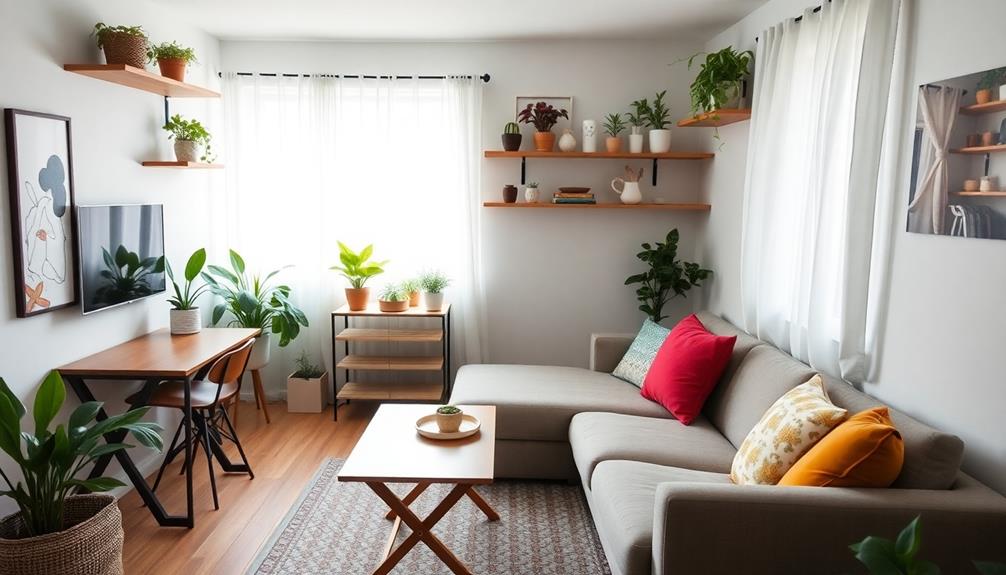
When choosing furniture for tiny spaces, it's essential to take into account scale and proportion to avoid a cramped feeling.
Emphasizing minimalism, you can create a safe and clutter-free environment that feels more open.
Opt for light-colored, multi-functional pieces that enhance openness while serving multiple purposes, such as space maximization.
Scale and Proportion
Choosing the right furniture for tiny spaces can make all the difference in creating a comfortable and inviting environment. Focus on scale and proportion when selecting your pieces. Oversized furniture can overwhelm a small room, making it feel cluttered.
Instead, choose appropriately sized items that enhance openness and flow, much like the principles of Balinese indoor-outdoor living that emphasize seamless connectivity and harmony. Low-profile coffee tables and small round tables are excellent choices since they occupy less visual weight and allow for easier movement.
When it comes to sofas, opt for a slim design rather than a bulky sectional, as this greatly improves the overall balance and proportion of your space. Additionally, consider the height and visual lines of your furniture. Lower pieces can create a sense of spaciousness, while taller items draw the eye upward, enhancing the perception of height.
Incorporating multi-functional furniture, like ottomans that serve as both seating and storage, maximizes utility without sacrificing style.
Multi-Functional Pieces
In the domain of tiny spaces, embracing multi-functional pieces can dramatically enhance your living experience. Choosing the right multi-functional furniture, like sofa beds and storage ottomans, allows you to make good use of your limited space while eliminating the need for extra items. This not only keeps your room tidy but also guarantees it feels bigger and more inviting.
Consider incorporating Indonesian decorative pillows that bring vibrant colors and intricate patterns, adding a cultural touch while providing comfort.
Consider selecting folding tables or modular shelving that adapt to your needs, giving you flexibility without overcrowding your area. Investing in furniture with built-in storage, such as benches or coffee tables with compartments, helps maintain a clutter-free environment.
Low-profile designs, like lightweight chairs and small round tables, create an open feel, making your space appear larger while still serving essential functions.
Light-Color Furniture Choices
Opt for light-colored furniture to create an illusion of spaciousness in your tiny space. Choosing light-color furniture choices, like whites, creams, and soft pastels, can make your small rooms feel more open and airy. These hues reflect natural light, enhancing brightness and inviting warmth into compact living areas.
Additionally, consider incorporating natural materials like jute or linen, which can complement light colors while adding texture and warmth to your decor. This approach enhances the overall flow of the room, making it feel more organized and expansive. Combining Aesthetic and Nautical Room Decor can also inspire you to add subtle nautical elements that maintain a light and breezy atmosphere.
Select smaller, low-profile furniture pieces in these light shades to avoid overwhelming your space. This approach enhances the overall flow of the room, making it feel more organized and expansive.
Additionally, opt for sleek designs with minimalistic features to reduce visual clutter—this can have a huge impact on how you perceive the room.
To add depth without sacrificing openness, incorporate light-colored accessories such as cushions or throws. These elements can introduce texture while maintaining a cohesive look that complements your furniture.
Creative Multipurpose Designs
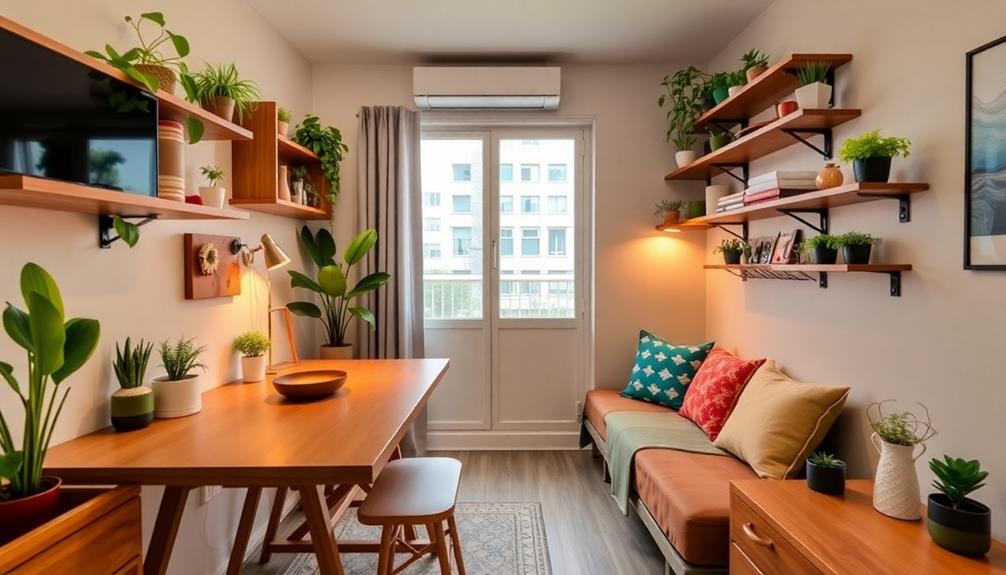
Creativity shines in multipurpose designs, especially when it comes to maximizing tiny spaces. You can transform your living area into a guest room with versatile multipurpose furniture like sofa beds or storage ottomans, minimizing clutter while enhancing functionality.
Incorporating elements from luxury tropical design aesthetics can also elevate the ambiance of small spaces. Horizontal Murphy beds are another innovative solution, effortlessly converting a bedroom into an office without sacrificing style.
Foldable tables and chairs are essential for small dining areas, allowing you to store them compactly when not in use, yet easily accommodating more guests during gatherings.
Smart designs, such as built-in bookshelves and wall-mounted desks, utilize vertical space effectively, creating additional functionality without taking up valuable floor space.
Modular furniture pieces offer adaptability and can reconfigure to suit various layouts and activities. This flexibility allows you to change your living space according to your needs, enhancing usability and aesthetics.
Innovative Storage Solutions
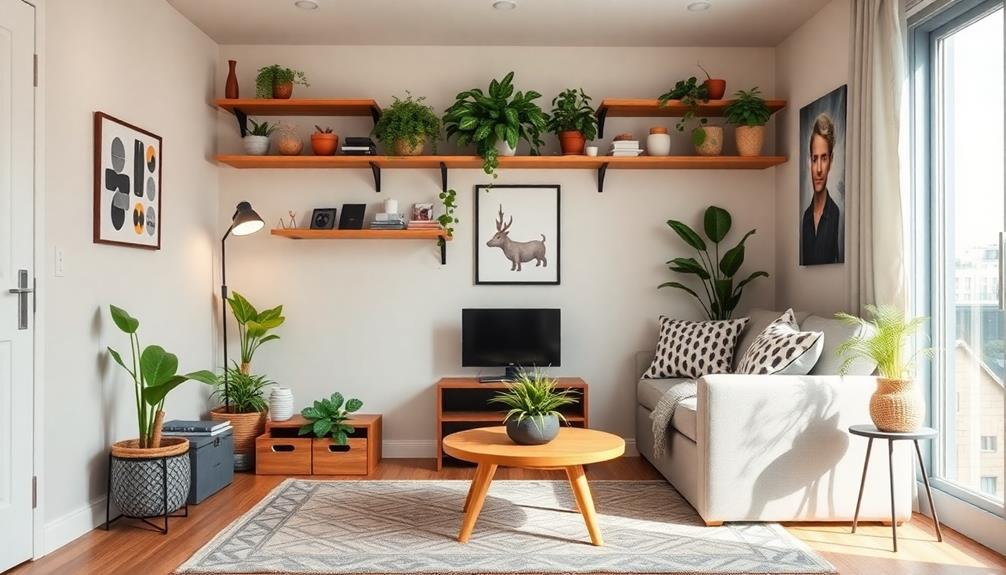
When you're working with limited space, innovative storage solutions can be a game-changer.
Consider incorporating multifunctional furniture that not only provides seating but also hides away your belongings, maximizing both style and functionality.
Think about utilizing hidden options like under-bed compartments or vertical shelves that free up floor space while keeping your essentials organized.
Hidden Storage Options
How can you make the most of limited space while keeping your home organized? Embrace hidden storage options that allow you to maximize every inch of your tiny rooms. Built-in furniture, like benches and ottomans, can conceal storage without sacrificing style, helping you maintain a chic look while keeping clutter at bay.
Additionally, consider incorporating traditional Indonesian housing concepts, which often feature elevated structures and multifunctional designs that promote efficient use of space.
Consider under-bed storage solutions, such as drawers or boxes, to keep seasonal clothing and other items hidden yet easily accessible. This clever tactic maximizes your bedroom space, ensuring that you utilize even the areas often overlooked.
Wall units are another fantastic way to integrate shelving and storage seamlessly. They help you stay organized while adding visual interest to your decor.
Multi-functional furniture is a game changer, too; think coffee tables with hidden compartments or sofas with storage built into the base. These pieces considerably reduce clutter and enhance functionality in your living area.
Vertical Storage Solutions
Maximizing vertical space can transform tiny areas into functional, organized havens. By implementing vertical storage solutions, you can effectively utilize unused wall space, enhancing both the functionality and aesthetic of your small living room.
Consider installing wall-mounted shelves and cabinets; these not only keep your belongings organized but also free up valuable floor area. To add a touch of Bohemian charm, consider incorporating wall art or decorative hangings that reflect your personal style.
Opt for tall bookshelves or vertical cabinets that reach upward, providing ample storage without crowding your space. You can also use pegboards or wall hooks for a creative way to organize tools and accessories, keeping surfaces clear and items easily accessible.
Don't forget about the charm of vertical gardens or wall-mounted planters. These not only save space but also introduce greenery, improving air quality in your tiny environment.
Incorporating furniture pieces with built-in vertical storage, like multi-functional shelving units or storage ottomans, can help you maintain a clutter-free atmosphere while adding style.
Customization for Unique Spaces
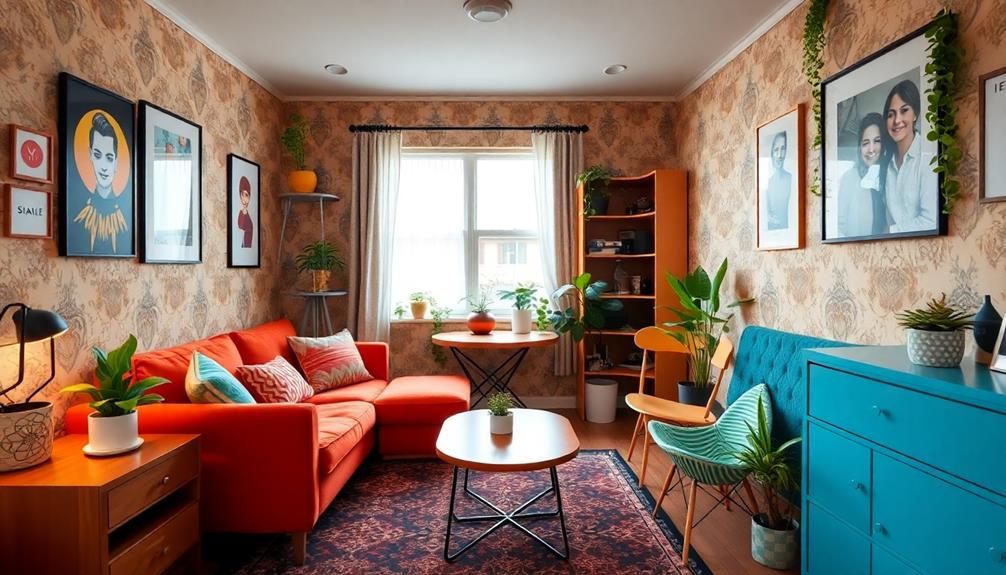
Creating a cozy and functional home in a tiny space often requires a touch of customization. With custom furniture designed to fit your room's irregular dimensions, you can guarantee every inch is utilized efficiently. Tailored pieces, like built-in shelving or unique cabinetry, not only address specific storage needs but also reflect your personal style.
Additionally, incorporating elements from tropical villa plans can enhance the open and airy feel of your tiny space.
Consider incorporating non-traditional designs, such as wall-mounted desks or foldable tables, which maximize functionality without compromising aesthetics. These pieces can be easily tucked away when not in use, keeping your space open and inviting.
Additionally, creative configurations, like multi-level platforms or lofted beds, transform underused vertical space into practical and stylish solutions, optimizing every corner of your home.
Investing in custom solutions enhances the overall flow and usability of your tiny space. You'll find that a personalized approach not only meets your specific needs but also creates a harmonious environment that feels uniquely yours.
Enhancing Aesthetics With Decor
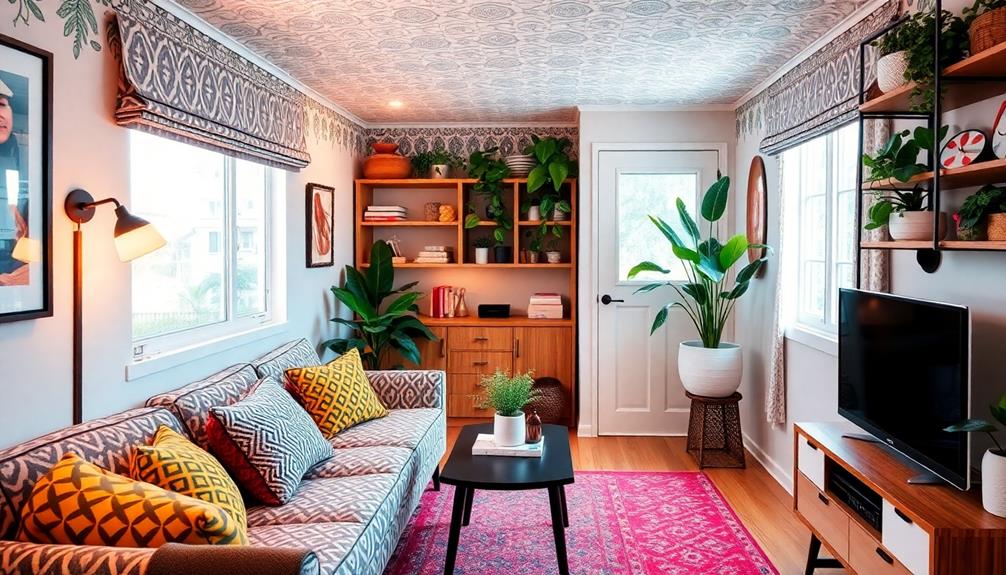
Customizing your tiny space not only enhances functionality but also sets the stage for aesthetics that truly reflect your style. To elevate your room's look, consider some smart design ideas. Wall-mounted fixtures and shelves keep the floor clear, making it feel larger and more organized. This simple trick helps create a seamless, open environment.
Another effective styling trick is to place mirrors opposite windows. This strategy maximizes natural light and creates an illusion of depth, which can transform your space dramatically. Additionally, using light colors in your decor—like soft hues or whites—will reflect light and contribute to an airy atmosphere. You'll discover that these choices make small spaces feel more inviting.
When it comes to decor pieces, opt for a few impactful items instead of overcrowding the area. This approach not only allows your personal style to shine through but also creates an elegant and cohesive look.
Utilizing Color and Light
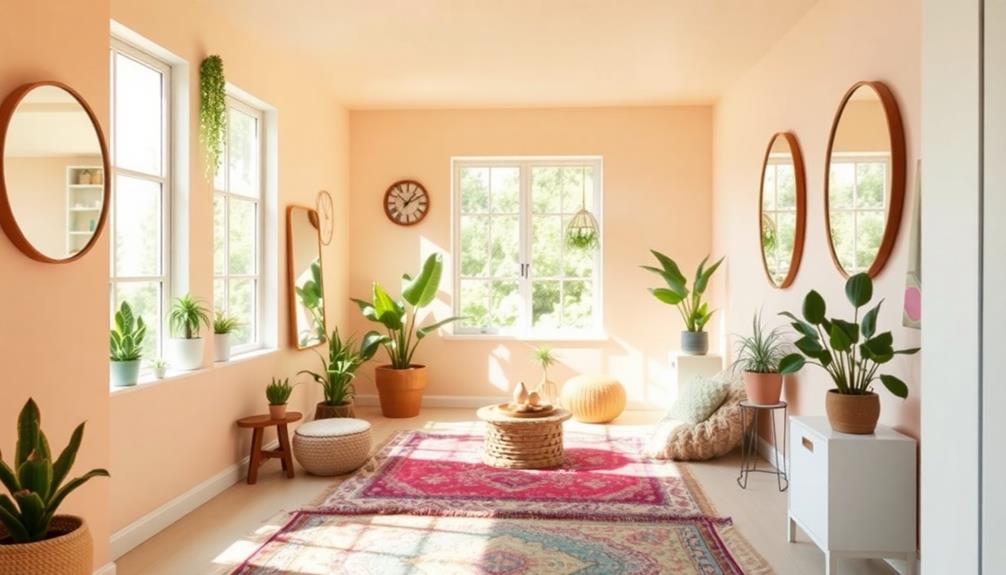
Color and light play an essential role in altering tiny spaces into inviting havens. To maximize your small area, consider painting the walls and ceiling in light colors like whites and soft pastels. These hues greatly increase light reflection, making the room feel larger and more open.
A monochromatic color palette can also help create a seamless shift between surfaces, enhancing that sense of continuity.
Incorporate mirrors strategically, especially opposite windows, to enhance natural light and visually expand the space. This simple addition can work wonders in making the room feel airy and bright.
You can introduce bright accent colors through decor items like cushions or artwork, injecting personality and vibrancy without overwhelming the small area.
Layered lighting is another key component. Combine ambient, task, and accent lighting to enhance the overall ambiance and functionality of your room.
This approach not only makes the room feel more inviting but also allows you to adapt the lighting to suit different activities, enhancing comfort throughout the day.
Smart Layout Configurations

When it comes to maximizing tiny spaces, smart layout configurations can make all the difference in how the area feels and functions. Consider unconventional layouts like L-shaped or U-shaped arrangements to improve flow and interaction between furniture pieces.
Zoning areas within the room is vital; strategically placing rugs can define distinct spaces for dining or working, making each area purposeful.
To enhance comfort and safety, avoid sharp corners and choose round tables or furniture with soft edges. This small change creates a more inviting atmosphere.
Don't forget about utilizing vertical space! Tall shelving units or wall-mounted fixtures draw the eye upward, keeping the floor clear and giving the illusion of height.
Integrating multi-functional furniture is another important element. Items like ottomans that double as storage or foldable tables allow you to adapt the layout for varying needs without overcrowding the space.
Incorporating Reflective Elements

Incorporating reflective elements can dramatically transform tiny spaces, making them feel more open and inviting. One of the simplest ways to achieve this is by using mirrors. They create an illusion of depth, reflecting light and your surroundings, which can make any small kitchen or living area appear larger.
Here are some effective ways to incorporate reflective elements:
- Strategically place mirrors: Position them opposite windows to maximize natural light and enhance that spacious feel.
- Use high-shine surfaces: Opt for glossy tiles and lacquered furniture that amplify brightness, contributing to an airy atmosphere.
- Decorative mirrors: Choose mirrors that double as art pieces. They can add visual interest while still providing practical benefits.
Frequently Asked Questions
How Do You Make a Small Room Look Bigger Interior Design?
To make a small room look bigger, use light colors on walls, place mirrors opposite windows, choose appropriately sized furniture, implement vertical storage, and arrange furniture for clear pathways to enhance spaciousness and flow.
How Do You Make a Big Room Feel Small and Cozy?
To make a big room feel small and cozy, use warm colors, layer lighting, arrange furniture into intimate groupings, add soft textiles, and personalize with decor. These elements create an inviting, snug atmosphere you'll love.
How to Make a Small Space Look Expensive?
To make a small space look expensive, choose a light color palette, invest in plush textiles, hang large artwork, select multi-functional furniture, and layer diverse lighting. These elements create sophistication and elevate your space's overall aesthetic.
How to Decorate a Narrow Space?
To decorate a narrow space, you'll want to use vertical storage, light colors, and slim furniture. Add mirrors for depth, and define areas with rugs to create an organized, open feel. You'll love the results!
Conclusion
In tiny spaces, you can achieve big style by maximizing functionality, choosing the right furniture, and embracing innovative storage solutions. You'll create a cozy atmosphere by incorporating reflective elements, utilizing color and light, and customizing your decor to fit your unique needs. With smart layout configurations and creative multipurpose designs, you'll transform your small room into a stylish haven. Remember, it's not about the size; it's about the style and how you make every inch count! To achieve a stylish look in a small space, consider incorporating minimalist interior decor tips. This can include choosing streamlined furniture, opting for a neutral color palette, and decluttering your space to create a sleek and modern feel. Embracing a minimalist approach will not only make your room look more spacious, but it will also help you maintain a clean and organized living environment. Ultimately, by implementing these strategies, you can make the most out of your tiny space and create a stylish, functional, and inviting home.
